Roseau is the capital of Dominica. The city is known for its colonial architecture and natural surroundings, including nearby waterfalls and hot springs.
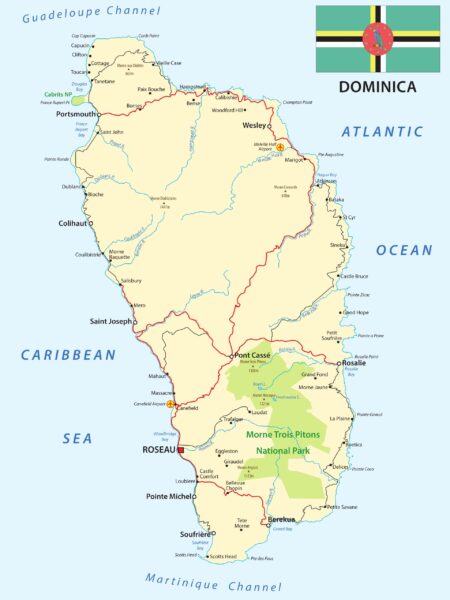
Roseau seamlessly blends modern amenities with traditional Caribbean allure through its diverse shops, restaurants, and historical landmarks. Serving as Dominica’s administrative and educational hub, the city has government buildings, schools, and colleges.
Where is Roseau?
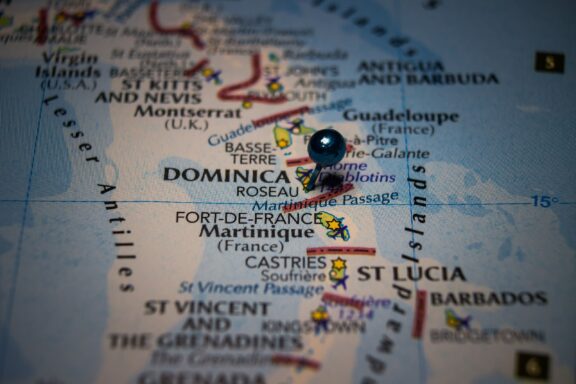
Roseau lies along the southwestern shoreline of Dominica, a Caribbean island nation. It lies in the Lesser Antilles chain, a subset of the West Indies. As a key maritime entry point within Dominica, Roseau is not far from the island’s southernmost region.
The city is strategically located near the outlet of the Roseau River, originating from the island’s interior. Hills encircle Roseau, about 15 miles from Scott’s Head, the island’s southern extremity. Its coordinates are approximately 15.3° N latitude and 61.4° W longitude.
History of Roseau
Before the arrival of Europeans, the area where Roseau now stands was part of the territory of the Kalinago people. These indigenous inhabitants lived off the land and waters, engaging in fishing, hunting, and small-scale agriculture. The Roseau River was likely an essential natural resource for the Kalinago community.
In the late 17th century, French explorers and settlers began to establish themselves in the area. Under French rule, the settlement that would become Roseau began to develop with the introduction of sugar plantations and other forms of agriculture.
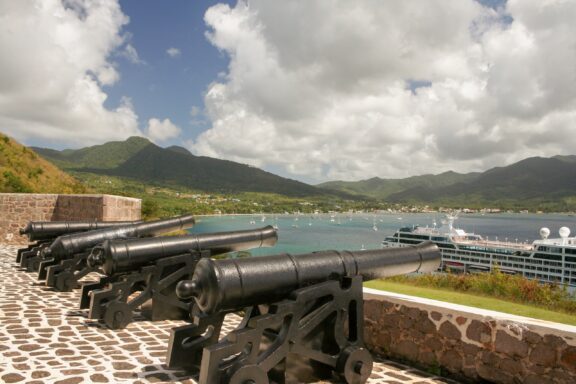
Wooden structures were replaced with more durable buildings made of stone, and the city’s street plan started to take form. Catholicism also gained prominence, marked by the construction of churches.
After oscillating between French and British control, Roseau was finally established as a British territory. The British introduced new laws, administrative structures, and institutions, such as schools and government buildings.
During this period, Roseau also became an essential port for the British Empire, contributing to its growing importance in trade and governance. English became the primary language, although French influences remained evident in culture and architecture.
During the early 20th century, Roseau began to modernize in terms of infrastructure and public services. Electricity, paved roads, and telecommunications arrived in the city. As Dominica moved toward independence, Roseau was the epicenter of political activity, hosting meetings, protests, and events aimed at ending British colonial rule.
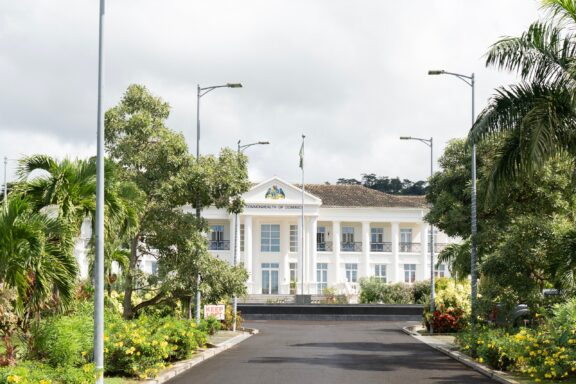
After Dominica gained independence on November 3, 1978, Roseau experienced growth and challenges. The government invested in new infrastructure, including educational and health facilities.
The city embraced its role as the nation’s capital, expanding its administrative and public service positions. Tourism also became a key industry, with Roseau as the primary entry point for exploring Dominica’s natural beauty.
Roseau has faced several challenges in the past few decades, including natural disasters like hurricanes, which have caused substantial damage.
However, the city has shown a solid ability to rebuild and adapt. Efforts have been made to strengthen infrastructure against future storms, and economic diversification has been a focus to ensure long-term sustainability.
Features of Roseau
Roseau is a city of contrasts and harmonies. Walking through its streets, you’ll immediately notice the diverse architectural styles telling its prosperous history. From the colonial charm of the French Quarter to the stately British-era buildings, each corner of the city has its own story to tell.
The city’s ability to bounce back from challenges, particularly natural disasters like hurricanes, adds a layer of resilience to its character. The blend of cultural influences, natural beauty, and modern amenities makes Roseau a fascinating city that captures the essence of Dominica.
Geography and Climate
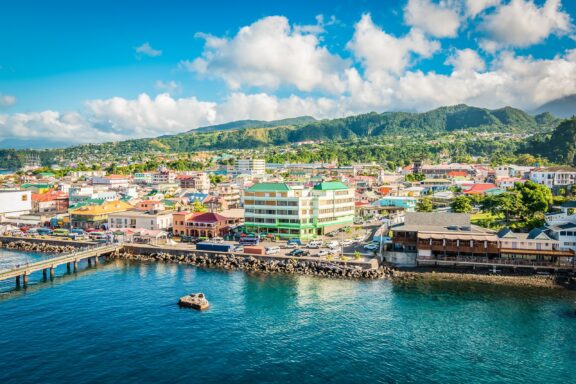
Roseau is nestled between lush hills and the Caribbean Sea, offering a scenic landscape that combines urban and natural elements. The climate is tropical, characterized by warm temperatures year-round.
Rainfall is abundant, particularly during the wet season from June to October. While hurricanes are a risk, the city has taken measures to become more resilient to such natural events.
Population
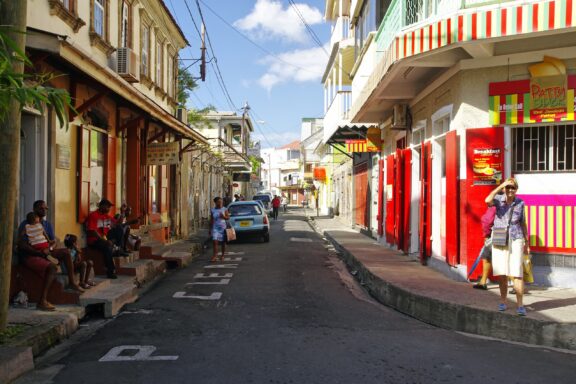
Roseau is a relatively small but diverse city with a population of around 17,000. The residents are predominantly of African descent, but you’ll also find people of mixed heritage and small communities of Europeans and Asians.
English is the official language, but you’ll often hear a mix of French Creole spoken among locals. Roseau is Dominica’s cultural and social hub, and it’s common to see lively gatherings and celebrations, particularly during the annual Carnival season.
Economy
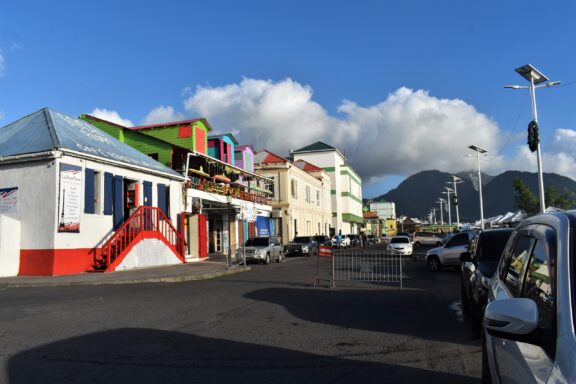
Roseau is the economic heart of Dominica. The city’s natural beauty and historical landmarks make tourism a major industry.
The port of Roseau plays a crucial role in the city’s economy, handling cargo and cruise ships. Apart from tourism, the city is a center for local commerce and governance, housing various government institutions and offices.
Agriculture, mainly the export of fruits like bananas, also contributes to the city’s economic fabric. In recent years, efforts to diversify the economy have led to investments in information technology and renewable energy sectors.
Things to Do and Places to See in and Around Roseau
Many tourists use Roseau as a base for exploring the island’s famed natural sites. Here are some of the most sought-after activities and popular attractions that Roseau and its vicinity have to offer:
1. The Old Market
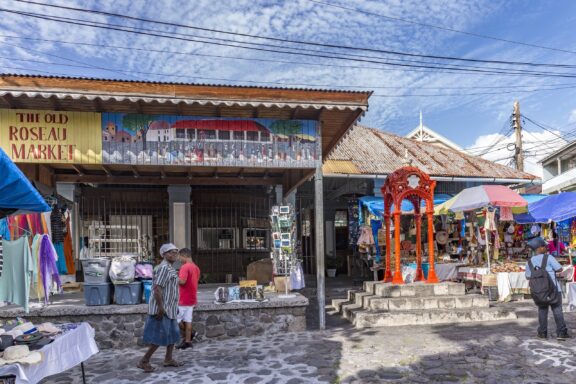
The Old Market is a living testament to the island’s complex history and vibrant present. Evolving from its dark past to its current role as a haven for local artisans, this is a place where you can feel the heartbeat of Dominica.
Once here, you can expect an authentic experience, with the opportunity to interact with locals and learn about the island’s traditions. It’s an ideal place to shop for souvenirs with real cultural significance.
2. Dominica Museum
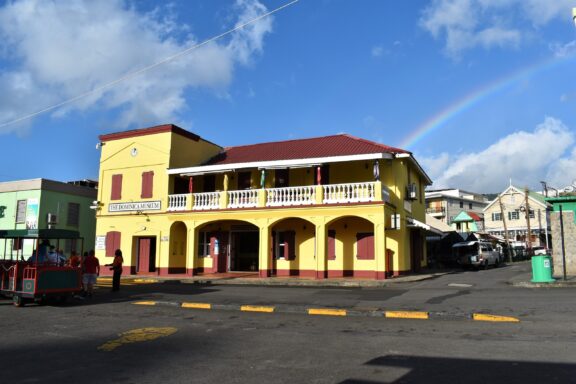
Dominica Museum serves as an intellectual gateway to understanding the multifaceted heritage of the island. Housed in an elegantly restored historical building, the museum offers a scholarly approach to Dominica’s diverse landscape and culture.
Inside, you’ll find several rooms in the museum dedicated to various aspects of the island’s history and natural wonders. Exhibits range from maritime history to the island’s biodiversity. There are also interactive displays designed to engage both adults and children.
3. Morne Bruce
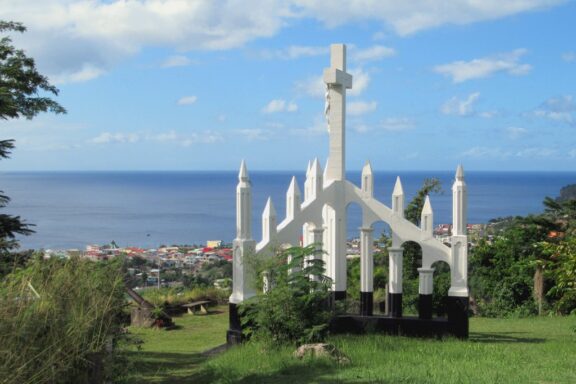
Once serving military purposes, Morne Bruce now stands as a location for contemplation and panoramic vistas of Roseau and its surroundings. As you ascend Morne Bruce, the city’s noise fades away, replaced by the tranquility of nature.
The hill features well-marked paths and resting spots, inviting visitors to relax and absorb the scenery. The panoramic views include Roseau, distant mountain ranges, and sometimes even ships setting sail.
4. Champagne Beach
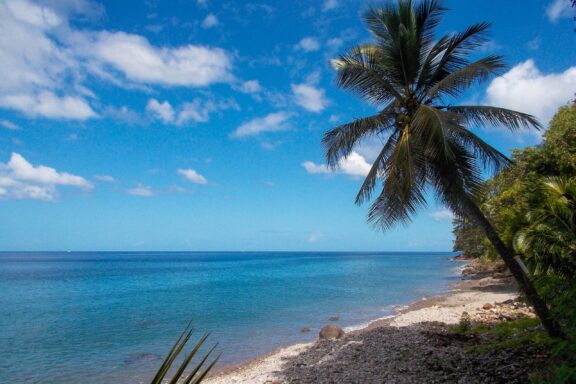
Champagne Beach is a marine wonder created by the island’s volcanic activity. Divers and snorkelers, in particular, hold this beach in high regard, as it offers an experience unlike any other.
In addition to its sandy shores, the primary attraction is underwater. Bubbles rise from the seafloor, like swimming in a bottle of champagne. The underwater world is equally compelling, with vibrant coral reefs and diverse sea life.
5. Trafalgar Falls
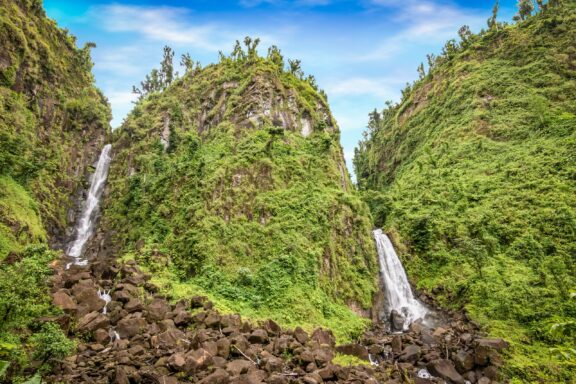
Trafalgar Falls captivates tourists with its twin cascades. This natural wonder promises awe and adventure against the lush backdrop of Dominica’s rainforest. The falls are separated into the “Mother” and “Father” falls, each with unique characteristics and charm.
Beyond the mere spectacle of cascading water, Trafalgar Falls offers hiking opportunities and the chance to enjoy a natural spa experience in its warm thermal pools. It’s a multi-layered attraction that caters to those looking for both relaxation and outdoor excitement.
6. Victoria Falls
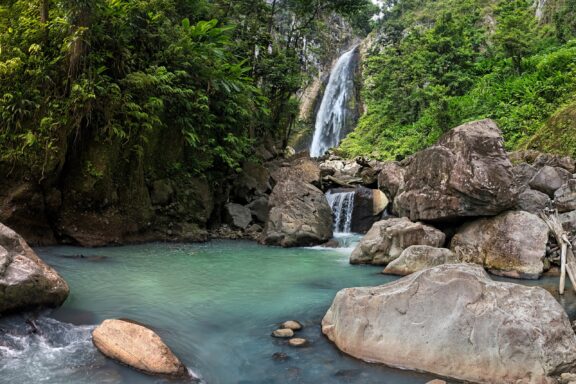
Victoria Falls offers an opportunity to experience unspoiled nature. Accessible only by a river hike, the journey to the falls is as rewarding as the destination. As you traverse the river, you’ll experience a variety of terrains and natural beauty, culminating in the striking view of the falls cascading down a rocky cliff.
Victoria Falls delivers for those looking for an adventurous and somewhat challenging experience. Visitors can swim in the pool below the falls or take in the beauty of the surroundings. It’s a perfect excursion for those wanting to venture off the beaten path.
7. Emerald Pool
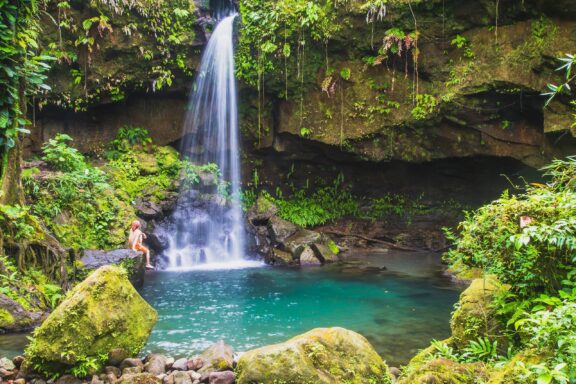
A short, scenic trail through the rainforest brings you to the Emerald Pool, crowned by a petite waterfall. The water maintains a refreshing, constant temperature, making it inviting for a swim year-round.
The Emerald Pool is ideal for people of all ages and fitness levels, as the hike to the pool is relatively mild. It’s an excellent spot for family outings or a romantic escape, and the natural beauty makes it a perfect subject for photography.
8. Titou Gorge
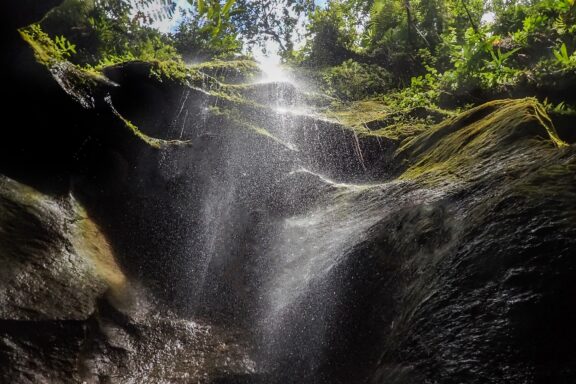
Titou Gorge is a thrilling natural feature that showcases Dominica’s geological prowess. Formed by molten lava that carved its way through the earth, the gorge is a haven for adventurers and nature enthusiasts alike.
The gorge consists of towering rock walls enclosing a narrow crystal-clear water channel. Sunlight filters through the foliage above, creating dappled patterns on the water’s surface. The ambiance is both majestic and intimate.
Frequently Asked Questions
How do I get around Roseau?
Public buses and taxis are available for local travel. Walking is also feasible for shorter distances, as Roseau is relatively compact.
Are there guided tours available for exploring historical sites?
Yes, guided tours are available for historical sites, and some also cover natural attractions around Roseau.
Where can I find authentic local cuisine?
Local eateries and restaurants in the Old Market and French Quarter offer authentic Dominican food.
What is traditional cuisine like in Roseau, Dominica?
The traditional cuisine of Roseau is a melting pot of influences, primarily shaped by African, European, and indigenous Kalinago culinary traditions. It heavily features local produce, seafood, and spices.
Root vegetables like yams, and dasheen and fruits like plantains are common ingredients. Over the years, the cuisine has also been influenced by global flavors, but it retains its core focus on fresh, locally sourced foods.
What are some authentic must-try local dishes?
If you’re in Roseau, there are a few dishes you absolutely must try to get a real taste of the local cuisine.
1. Calaloo Soup: A hearty green soup made primarily from dasheen leaves and various local vegetables.
2. Mountain Chicken: Despite its name, this dish features frog legs, seasoned and fried.
3. Saltfish and Bakes: Salted codfish served with fried dough, usually enjoyed as a breakfast item.
4. Breadfruit and Codfish: A dish featuring roasted or boiled breadfruit with a sautéed codfish.
What are some interesting facts about Roseau?
• Roseau is named after the reeds once found along the banks of its river, with “Roseau” being the French word for “reed.”
• Roseau is home to one of the oldest and most vibrant Carnival celebrations in the Caribbean, with roots tracing back to the 18th century.
Final Thoughts
Roseau is a captivating blend of natural beauty, cultural richness, and historical significance in a welcoming Caribbean atmosphere. From its scenic landscapes and vibrant local markets to its intriguing museums and lively festivals, the city offers a well-rounded experience for travelers.
Whether you’re an adventure seeker, a history buff, or simply looking to unwind, Roseau has something to offer. It is undoubtedly a destination worth visiting for a genuinely enriching and diverse experience.
Image Sources and Copyright Information
- Map of Dominica: © Rainer Lesniewski/Shutterstock
- Location Pin on Roseau, Dominica Map: © Zarko Prusac/Shutterstock
- Old Cannons Overlooking Sea at Fort Shirley: © Alan L Meakin/Shutterstock
- Government House in Roseau with Driveway and Landscaped Gardens: © Renata Ty/Shutterstock
- Coastal City Skyline with Mountains in the Background: © NAPA/Shutterstock
- Street Scene with Locals in Roseau: © Rafal Michal Gadomski/Shutterstock
- Colorful buildings lining a street in Roseau with mountains in the background: © Nandani Bridglal/Shutterstock
- Old Market in Roseau with Shoppers and Stalls: © travelview/Shutterstock
- Yellow Building with Balcony and Rainbow: © Nandani Bridglal/Shutterstock
- Cross Monument Overlooking Coastal Town: © David Stanley/Flickr
- Tropical Beach with Palm Tree: © Randolf Rautenberg/Flickr
- Twin Waterfalls Amidst Greenery: © NAPA/Shutterstock
- Tropical Waterfall and Rock Pool: © Derek D. Galon/Shutterstock
- Person by Emerald Waterfall and Pool in Lush Forest: © Juancat/Shutterstock
- Sunlit Waterfall in Lush Forest: © Gail Johnson/Shutterstock